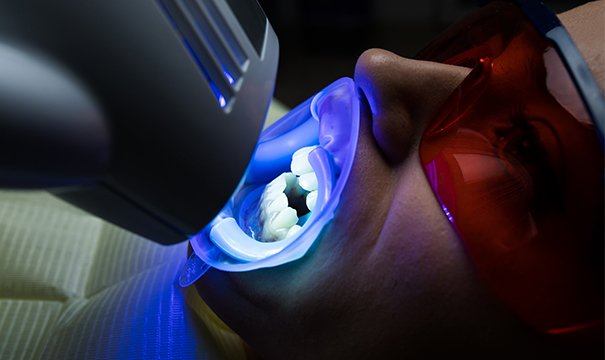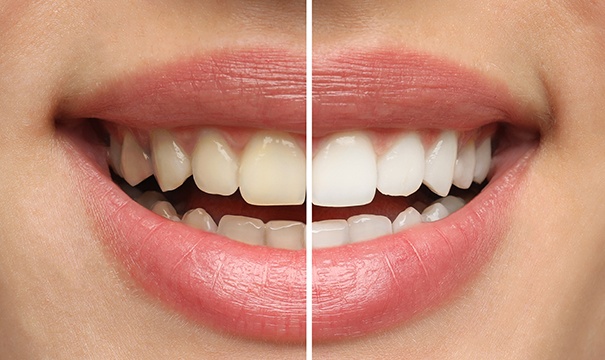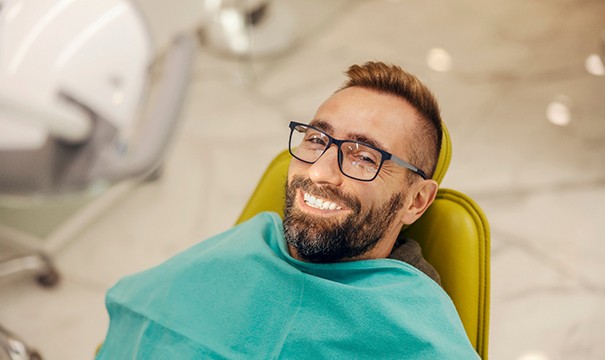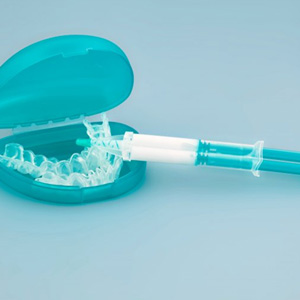Teeth Whitening – Attleboro, MA
Make Your Smile Brighter Than Ever
Have you been up and down the oral hygiene aisle at the local grocery store trying teeth whitening toothpastes, mouthwashes, strips, and gels with little to no change in the shade of your smile? Are you spending your spare time checking out dubious DIY smile-brightening ideas on YouTube? Put down the white strips, leave the charcoal in the grill, and call Capron Park Dental to schedule an appointment! Our talented dentists and team in Attleboro offer a variety of cosmetic dentistry solutions to deliver flawless smiles, including take-home teeth whitening treatments.
Why Choose Capron Park Dental for Teeth Whitening?
- Uses Professional-Grade Bleaching Solutions
- Custom-Made Trays Ensure Even Coverage
- Brighten Your Smile in Just Two Weeks
Who is a Good Candidate for Teeth Whitening?

Before we begin the teeth whitening process, we need to complete a comprehensive oral exam. After all, brightening gels should not be used on decayed teeth or infected gums. Once we’ve confirmed that your smile is healthy (or provided the necessary restorative care), we will learn all about your smile goals, including how subtle or dramatic you want the results to be. The good news is that many patients with healthy smiles are good candidates for this cosmetic dental procedure, including those who are looking to achieve a brilliantly white smile.
Causes of Dental Discoloration

Of course, before we recommend teeth whitening, we want to understand the underlying causes of your dental discoloration. There are many reasons teeth may become discolored, but some of the most common causes of tooth staining include:
- Consumption of dark-colored foods and drinks
- Tobacco use
- Enamel wear, which reveals the yellow dentin layer of the tooth
- Overconsumption of fluoride during dental development may lead to brighter white spots on teeth
- Taking tetracycline medications during dental development may cause dark stripes on the surfaces of teeth
- Some people are genetically predisposed to have darker tooth coloring
Extrinsic Vs. Intrinsic Staining
There are two different types of stains that can occur in your smile: extrinsic and intrinsic.
Extrinsic staining occurs when there is staining on the outside of your enamel—the outer surface of your smile. This is usually caused by consuming foods or drinks rich in color. Additionally, this type of staining will happen gradually over time.
Intrinsic stains affect the dentin, which is the underlying layer of the tooth. Discoloration in this area of the tooth is typically caused by trauma or taking medication, like tetracycline antibiotics. Plus, as you get older, your teeth naturally become worn down, which will eventually lead to intrinsic staining.
How Does Take-Home Teeth Whitening Work?

Teeth whitening relies on an active whitening agent to lift stains from the porous surfaces of teeth through a chemical process called oxidation. You may be familiar with oxidation in some of its less-positive manifestations, like causing rust, but oxidation is also how we clean clothes and dishes as well as whiten teeth.
If you choose to move forward with take-home teeth whitening, then we will provide you with everything you need – from the brightening gels to the custom applicators. We will also provide you with helpful instructions on how and when to use them so you get the results you desire. You should see improvements after just one use, and the full results should be on display in just two weeks!
Tips for Maintaining Your Brighter Smile

To maintain your bright, beautiful results, we recommend:
- Taking good care of your teeth at home
- Coming to our office twice a year for a checkup and cleaning
- Eating white fish, cottage cheese, and other light-colored foods
- Using a straw when drinking coffee
- Breaking bad habits, like smoking
Understanding the Cost of Teeth Whitening

Before committing to any dental treatment, it’s a good idea to count the costs. While there’s no set price for teeth whitening, we can help you understand your potential expenses and how you can save money on your new smile. Once we get the chance to take a closer look at your teeth and discuss your treatment goals, then our team will be able to break down your teeth whitening costs in more detail.
Factors that Affect the Cost of Teeth Whitening

Teeth whitening is one of the more “quick and simple” cosmetic treatments we offer, but there are still a couple of factors that can influence your overall expenses. For example:
- Stain severity. While most patients can see dramatic results after just one whitening treatment, others with more severe staining may need multiple appointments.
- Preliminary treatment. If you have a case of cavities or gum disease, we strongly recommend taking care of your condition before proceeding with teeth whitening.
- Existing dental work. Veneers, crowns, fillings, and other such restorations don’t respond well to teeth whitening agents. We can still polish or replace your dental work to match the new shade of your smile, but it’s good to keep in mind this does involve an “extra” step.
Types of Teeth Whitening: What Do They Cost?

To give you a sense of how different teeth whitening methods compare in price, we broke down their average costs. The math looks something like this:
- Professional take-home kit: Between $100 and $600.
- Store-bought kit: About $100 or less.
- Products like strips, gels, and toothpastes: These costs heavily depend on the store and brand you’re buying from. You can expect to spend anywhere from $7 to $40.
Professional Teeth Whitening Kits VS Store-Bought Solutions

True, professional take-home whitening kits are generally more expensive than their store-bought counterparts – at least at face value. What’s worth considering, though, is that you’ll need far more store-bought applications to get the same results as one round of a professional treatment. Many of our patients find that having their teeth whitened at Capron Park Dental is more effective, longer-lasting, and overall a better value than DIY solutions. Plus, our cosmetic dentists can fully customize your treatment plan to ensure the health and safety of your precious pearly whites.
Options For Making Teeth Whitening Affordable

Unfortunately, dental insurance doesn’t usually cover the cost of teeth whitening treatments. We believe in the power of a beautiful smile here at Capron Park Dental, so please – ask our friendly team about your financing options. Thanks to programs like Wisetack monthly payment plans and our very own membership plan, you could still save money on cosmetic dentistry in Attleboro.
Teeth Whitening FAQs
What’s the Difference Between Professional and Store-Bought Teeth Whitening?
Every tooth has three layers – the hard, porous outer enamel, the supportive, yellow dentin, and the soft pulp. The thicker and healthier the enamel, the brighter the smile. Teeth whitening agents create an oxidation reaction that bubbles through the porous enamel, lifting away stains. Unfortunately, saliva is constantly working to neutralize chemical reactions in the mouth, including oxidation. This is where store-bought teeth whitening solutions typically fail. They allow the saliva to access and neutralize the whitening agent, stopping the smile-brightening process in its tracks.
Can I Drink Coffee After Having My Teeth Whitened?
We don’t recommend drinking coffee immediately following your teeth whitening treatment. In fact, we recommend steering clear of all dark-colored beverages, including red wine, cherry juice, and soda. Instead, drink lots of water to stay hydrated and help prevent food particles from clinging to your teeth.
Tip: If your teeth are a bit sensitive, opt for room-temperature water!
Is There Anything I Shouldn’t Eat After Whitening My Teeth?
Since pigmented foods can cause stubborn stains to resurface, we recommend avoiding them entirely. A few examples include blackberries, tomato soup, and marinara sauce. If you can, opt for light-colored foods instead, like plain yogurt, egg whites, and bananas.
Does Teeth Whitening Hurt?
Many patients are hesitant to commit to dental treatment of any kind because they are worried that the process will be painful. Since professional teeth whitening is entirely custom, you are much less likely to experience tooth sensitivity. If your teeth are more prone to being sensitive, don’t hesitate to let us know! By spacing out treatments, avoiding hot beverages, and using specialty toothpaste, we can help you to avoid this unpleasant sensation.
Am I a Candidate for Teeth Whitening?
If you are struggling to smile confidently because of stubborn stains and pigmentation, you are likely a good candidate for the procedure. The best way to find out is by scheduling a consultation with us. During this visit, we will examine your smile and learn about the goals you have for your smile. If your teeth and gums are in good shape, we can start working on your treatment plan. If you have any dental issues, like a cavity or gum disease, we can plan to treat them before moving forward with your whitening treatment.
Does Teeth Whitening Damage Enamel?
No, teeth whitening doesn’t damage healthy enamel. However, if your teeth are affected by decay or gum disease, the chemical used to whiten your teeth can aggravate the issues. This is why it is so important to complete a dental exam beforehand. Overuse of whitening products can cause issues. If you want to whiten your teeth, you should always consult with a dentist first – even if you don’t choose professional treatment. This way, they can provide you with valuable insight to ensure that you safely achieve your goals.
Is Teeth Whitening Permanent?
No – teeth whitening is not permanent. Typically, results last anywhere from a couple of months to a few years depending on how well you care for your teeth. To prolong your results, it’s important to implement a solid at-home oral hygiene routine, see your dentist every six months, and avoid poor dental habits. Touch-up treatments are also available to keep your teeth bright and white!

